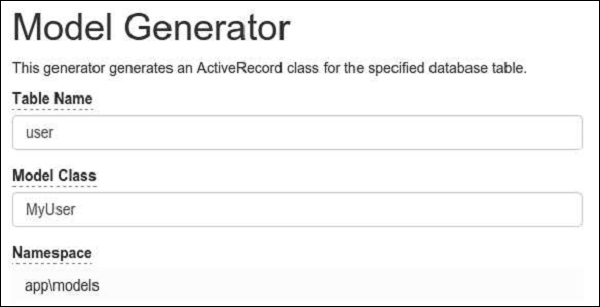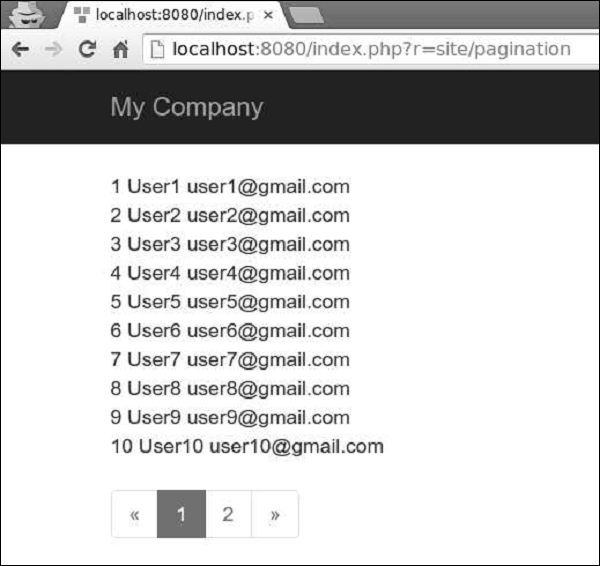Yii-ページ付け
1ページに表示するにはデータが多すぎる場合は、複数のページに表示する必要があります。これは、ページ付けとも呼ばれます。
ページネーションの動作を示すには、データが必要です。
DBの準備
Step 1−新しいデータベースを作成します。データベースは以下の2つの方法で作成できます。
ターミナルでmysql-u root-pを実行します
CREATE DATABASE helloworld CHARACTER SET utf8 COLLATEutf8_general_ciを使用して新しいデータベースを作成します。
Step 2 −でデータベース接続を構成します config/db.phpファイル。次の構成は、現在使用されているシステム用です。
<?php
return [
'class' => 'yii\db\Connection',
'dsn' => 'mysql:host = localhost;dbname = helloworld',
'username' => 'vladimir',
'password' => '12345',
'charset' => 'utf8',
];
?>Step 3 −ルートフォルダ内 run ./yii migrate/create test_table。このコマンドは、DBを管理するためのデータベース移行を作成します。移行ファイルはに表示されますmigrations プロジェクトルートのフォルダ。
Step 4 −移行ファイルを変更します(m160106_163154_test_table.php この場合)このように。
<?php
use yii\db\Schema;
use yii\db\Migration;
class m160106_163154_test_table extends Migration {
public function safeUp() {
$this->createTable("user", [
"id" => Schema::TYPE_PK,
"name" => Schema::TYPE_STRING,
"email" => Schema::TYPE_STRING,
]);
$this->batchInsert("user", ["name", "email"], [
["User1", "[email protected]"],
["User2", "[email protected]"],
["User3", "[email protected]"],
["User4", "[email protected]"],
["User5", "[email protected]"],
["User6", "[email protected]"],
["User7", "[email protected]"],
["User8", "[email protected]"],
["User9", "[email protected]"],
["User10", "[email protected]"],
["User11", "[email protected]"],
]);
}
public function safeDown() {
$this->dropTable('user');
}
}
?>上記の移行により、 user次のフィールドを持つテーブル:id、name、およびemail。また、いくつかのデモユーザーを追加します。
Step 5 −プロジェクトルート内 run ./yii migrate 移行をデータベースに適用します。
Step 6 −次に、モデルを作成する必要があります。 userテーブル。簡単にするために、Giiコード生成ツール。これを開くurl: http://localhost:8080/index.php?r=gii。次に、「モデルジェネレータ」ヘッダーの下にある「開始」ボタンをクリックします。テーブル名(「ユーザー」)とモデルクラス(「MyUser」)を入力し、「プレビュー」ボタンをクリックして、最後に「生成」ボタンをクリックします。

ザ・ MyUser modelはmodelsディレクトリに表示されます。
動作中のページネーション
Step 1 −を追加します actionPagination 方法 SiteController。
public function actionPagination() {
//preparing the query
$query = MyUser::find();
// get the total number of users
$count = $query->count();
//creating the pagination object
$pagination = new Pagination(['totalCount' => $count, 'defaultPageSize' => 10]);
//limit the query using the pagination and retrieve the users
$models = $query->offset($pagination->offset)
->limit($pagination->limit)
->all();
return $this->render('pagination', [
'models' => $models,
'pagination' => $pagination,
]);
}Step 2 −というビューファイルを作成します pagination.php 中 views/site フォルダ。
<?php
use yii\widgets\LinkPager;
?>
<?php foreach ($models as $model): ?>
<?= $model->id; ?>
<?= $model->name; ?>
<?= $model->email; ?>
<br/>
<?php endforeach; ?>
<?php
// display pagination
echo LinkPager::widget([
'pagination' => $pagination,
]);
?>次に、ローカルホストに移動します http://localhost:8080/index.php?r=site/pagination Webブラウザーを介して、ページ付けウィジェットが表示されます-
